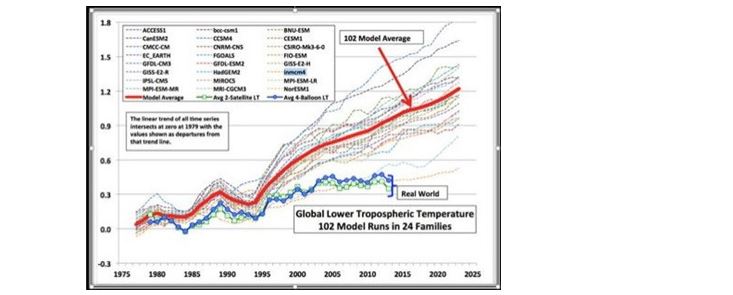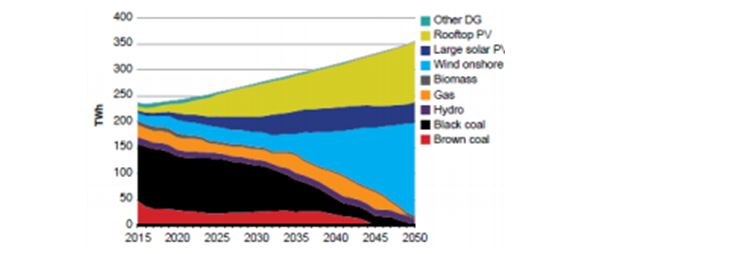Alan Moran The Wind Has Changed
Problem is, the Turnbull government hasn’t noticed that president-elect Trump is about to knock the well-funded wheels off the global alarmism industry, as his cabinet picks confirm. Instead, we’re told to lie back, think of Paris and make our own green rent-seekers so much richer.
In the climate field the next target is NASA. Who can forget how warmist pin-up scientist Brian Cox was allowed to show a NASA doctored temperature map in a Q&A gotcha moment designed to humiliate Senator Malcolm Roberts (presently in Washington at a meeting with Myron Ebell, who heads up Trump’s EPA transition team.) Gavin Schmidt, who has inherited the much-arrested catastropharian James Hansen in heading the climate-alarmist branch of NASA and has warned off Trump. Fat chance!
The action on the EPA adds to the targeting of NASA. Bob Walker, a former congressman and Trump’s space policy adviser, said he would like to shrink NASA’s Earth-monitoring programs. “We see NASA in an exploration role, in deep space research,” he said. “Earth-centric science is better placed at other agencies, where it is their prime mission.” An irony of history is that NASA acquired its responsibility for monitoring the atmosphere in 1985 under President Reagan.
One area of NASA that is unimpeachable is the global temperature satellite-based recordings of the UAH at Alabama by Dr Roy Spencer. These show a persistent undershooting (below) of the temperature compared to modellers’ forecasts.
 Back in 1991, we only had 11 years of evidence from satellite measurements of the lower troposphere (the area where the warming picture would be most readily seen). At that stage a US friend, a professor of meteorology, commented to me: “Don’t knock this global warming crap! It allows me to travel the world in comfort and to double my salary while doing consultancy work. And year by year the satellite data will come in so that, about when I am considering retirement in a dozen years’ time, the myth will be utterly discredited.”
Back in 1991, we only had 11 years of evidence from satellite measurements of the lower troposphere (the area where the warming picture would be most readily seen). At that stage a US friend, a professor of meteorology, commented to me: “Don’t knock this global warming crap! It allows me to travel the world in comfort and to double my salary while doing consultancy work. And year by year the satellite data will come in so that, about when I am considering retirement in a dozen years’ time, the myth will be utterly discredited.”
My American friend was, of course, right about the data discrediting the myth, but he misunderstood the impetus being unleashed from scientists, environmental activists and subsidy-seeking industrialists. Climate modellers refuse to learn from 37 years of data on climate outcomes, persisting with forecasts (amplified by their theoretical treatment of water vapour) that serve their own careers rather than scientific truth. In 1991, the issue was little more than a glint in the eye of the more science-oriented politicians — people like our own Science Minister Barry Jones.
It would be another six years before the first and hesitant regulatory steps were taken, with John Howard announcing a “target of an additional 2% of electricity to be sourced from renewable sources by 2010”. The ambiguous tone was swiftly reinterpreted and became quantified as 9,500 GWhs, a staging post to the current objective of subsidies to achieve 33,000 GWhs of large-scale generating capacity, plus perhaps 12,000 GWHs from roof tops. Current programs cost Australian consumers and taxpayers $5 billion a year, a staggeringly wasteful sum that grows larger as delusional policy is soldd as being in the country’s best interests.
The issue is being heightened in Australia ahead of next week’s meeting of energy ministers. This has been preceded by the release of the Terms of Reference into the post 2020 Climate Review. Mr Turnbull, having been forced by a backbench revolt, to abandon this as a catalyst for his renewed push for a carbon tax placed the blame for raising it on Josh Frydenberg, in the process cruelling the prospects of a possible leadership contender. Following the backdown, South Australia is threatening to go it alone with renewables and a carbon tax – the latest power outage shows how well that would go!
Ministers at next week’s meeting will hear from the team the PM assembled under Chief Scientist Alan Finkel (“We are losing the battle against climate change”) to examine the national electricity market. None of the team has experience in the key issue: the effect of intermittent wind energy on the wholesale market and its implications for transmission spending. Ministers will likely get another Magic pudding-style variation of the energy intensity tax that Turnbull was forced to disown. The variation that the Finkel group will offer aims to conjure the outcome of that tax as reduced energy costs, improved environmental outcomes, and a more hospitable world for investment. Such outcomes do not pass the smell test. Sadly, gullibility is not in short supply, so that the mistake of heeding interested parties, such as the Grattan Institute and Frontier Economics, is persuasive. For an example, see the Australian Financial review, which has already been suckered into accepting the bogus logic.
Magic puddings abound in the energy space. Only yesterday a paper prepared by our own CSIRO was published. It was choker-block with assumptions. CSIRO Chief Economist Energy, Paul Graham, said that “$16 billion in network expenditure could be saved by 2050 if the grid buys support services from customers with onsite resources”. According to the report, shifting to 100% renewables by 2050 would mean:
- $414 annual saving in average household electricity bills (compared with roadmap counterfactual, business as usual, pathway)
- A medium family which cannot take up distributed energy resources is over $600 p.a. better off through removal of cross-subsidies
The paper has the usual array of fanciful wavy lines just to prove it has been honest and diligent.
 Like NASA, CSIRO has become highly politicised over the years. At one stage in the Rudd Gillard era, science commentator Tom Quirk estimated that half the agency’s resources were directly and indirectly associated with the climate change issue. With the election of the Abbott government, this share fell — though perhaps only because programs were re-badged.
Like NASA, CSIRO has become highly politicised over the years. At one stage in the Rudd Gillard era, science commentator Tom Quirk estimated that half the agency’s resources were directly and indirectly associated with the climate change issue. With the election of the Abbott government, this share fell — though perhaps only because programs were re-badged.
The latest post-2020 energy policy review shows we are little advanced in restoring the energy market to the highly competitive one that offered contracts at $40 per GWh before ministerial interventions destroyed investment confidence and forced the replacement of cheap, reliable coal by wind. Energy contracts are now priced at over $100 in South Australia and $80 in Queensland. It appears that it will be some time before the unravelling of this, commencing with the government taking Senator Cory Bernardi’s advice and withdrawing from the doomed Paris Agreement, and removing all subsidies and spending on the carbon caper.
Alan Moran runs the website Regulation Economics
Comments are closed.
